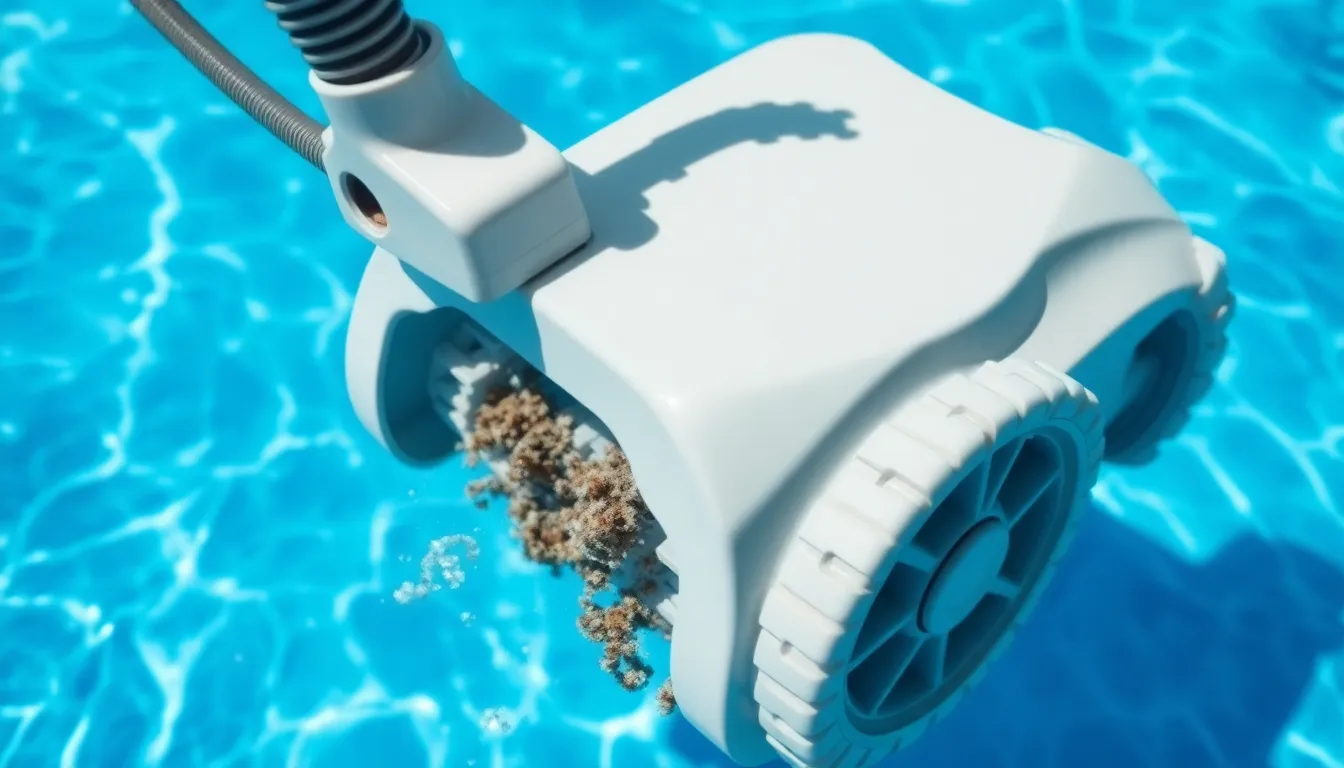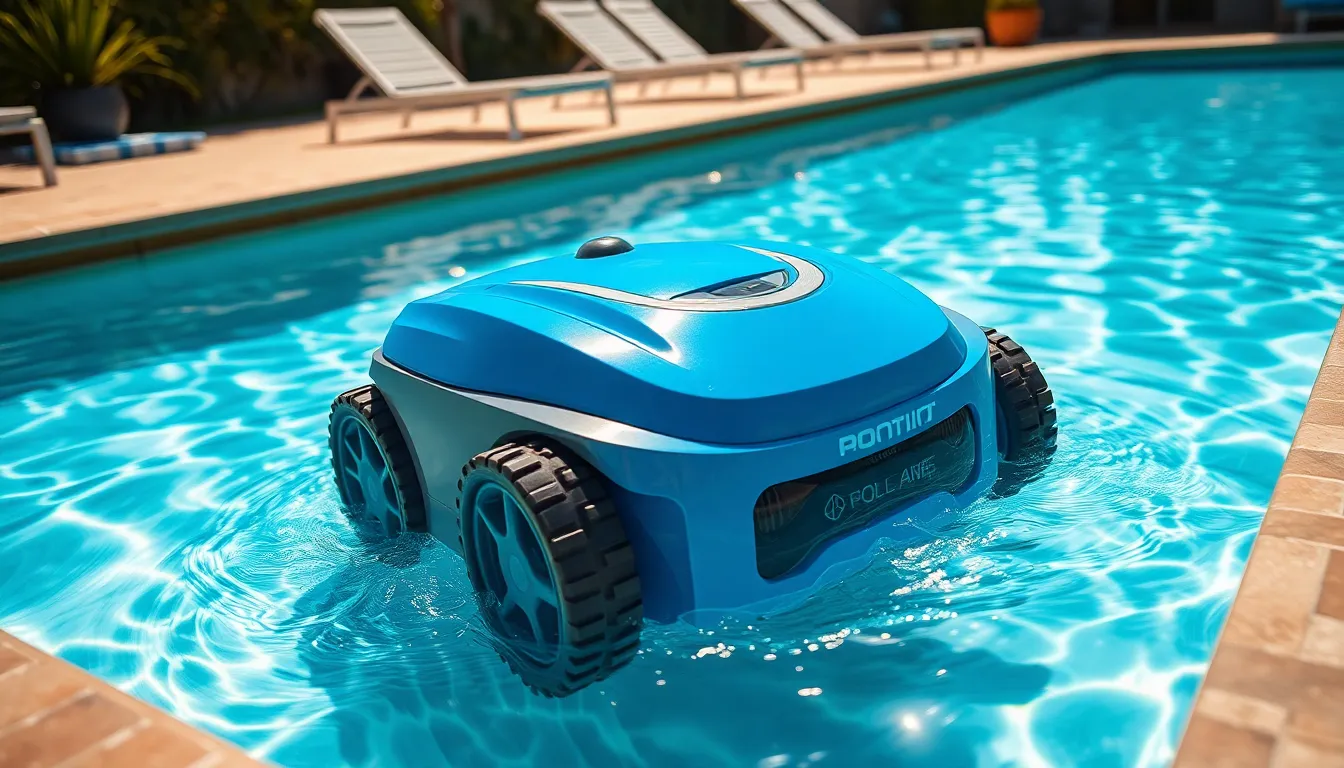Keeping a pool clean can be a chore, but automatic pool cleaners make the task easier. However, like any mechanical device, these cleaners can encounter issues that hinder their performance. Understanding how to troubleshoot and repair common problems can save time and money, ensuring a sparkling pool without the hassle.
In this guide, readers will discover essential tips for diagnosing and fixing automatic pool cleaner issues. From clogged filters to malfunctioning motors, knowing the signs of a problem can lead to quick solutions. With a bit of knowledge and the right tools, anyone can tackle these repairs confidently, keeping their pool in pristine condition all season long.
Table of Contents
ToggleUnderstanding Automatic Pool Cleaners
Automatic pool cleaners simplify pool maintenance by using advanced technology to remove debris, dirt, and algae. These devices operate without constant human intervention, which saves time and effort. Generally, automatic pool cleaners come in three main types: suction-side, pressure-side, and robotic cleaners.
- Suction-side cleaners attach to the pool’s filtration system. They work by drawing in debris through a hose. They utilize existing pool pumps for power.
- Pressure-side cleaners connect to the return side of the pool’s system. They use a propulsion mechanism to navigate the pool. They operate independently from the pool’s main filter, reducing strain on it.
- Robotic cleaners function autonomously, powered by an electric motor. They scour the pool floor, walls, and waterline, providing thorough cleaning. They often include features like programmable schedules and energy efficiency.
Understanding these types helps in troubleshooting specific issues. Common problems include clogged filters, damaged hoses, and malfunctioning motors. Addressing these concerns quickly preserves the cleaner’s efficiency and extends its lifespan. Regular maintenance, such as cleaning filters and checking hoses for wear, ensures optimal performance.
Common Issues with Automatic Pool Cleaners

Automatic pool cleaners may encounter several problems that affect their performance. Recognizing these issues allows for timely repairs and ensures efficient operation.
Clogs and Blockages
Clogs and blockages represent frequent problems in automatic pool cleaners. Debris accumulation in filters, hoses, or the cleaner’s suction openings can obstruct water flow. Signs of clogs include reduced suction power, irregular cleaning patterns, or the cleaner getting stuck. Regularly checking and cleaning filters and hoses prevents debris buildup. Removing any visible obstructions from the cleaner’s intake can restore normal operation.
Mechanical Failures
Mechanical failures can hinder the functionality of automatic pool cleaners. Common issues include malfunctioning wheels, damaged tracks, or broken brushes. Hesitating movement or unusual noises often signal mechanical problems. Inspecting the wheels and tracks for wear or damage is crucial. Replacing worn components, such as brushes, can improve cleaning efficiency.
Electrical Problems
Electrical problems can significantly disrupt automatic pool cleaner performance. Common symptoms include unresponsiveness, erratic movement, or failure to charge. Inspecting power cords for damage and ensuring connections are secure is advisable. If the cleaner uses a battery, replacing it when performance decreases is essential. Additionally, checking for blown fuses or tripped circuits may resolve electrical issues.
Tools Required for Repair
Having the right tools simplifies the repair process of automatic pool cleaners, ensuring efficiency and accuracy. Below are essential tools and safety equipment for effective repairs.
Essential Tools
- Screwdrivers: Flathead and Phillips screwdrivers assist in removing panel screws and accessing internal components.
- Wrenches: Adjustable wrenches enable users to tighten or loosen nuts and bolts securely.
- Pliers: Needle-nose and standard pliers help in gripping, twisting, and cutting wires or components.
- Socket Set: A complete socket set allows for easier removal of various fasteners with different sizes.
- Multimeter: A multimeter aids in diagnosing electrical issues by measuring voltage, current, and resistance.
- Hose Clamp Pliers: These specialized pliers are essential for removing and installing hose clamps securely without damaging the hoses.
- Replacement Parts: Keep common replacement parts, like filters, wheels, and brushes, on hand for quick fixes.
Safety Equipment
- Safety Glasses: Protects the eyes from debris and chemical exposure during repairs.
- Gloves: Nitrile or rubber gloves provide hand protection against sharp components and chemicals.
- Knee Pads: Wearing knee pads offers cushioning when working on the pool deck or ground.
- Face Mask: A face mask safeguards against inhaling dust and debris when working with filters and components.
- First Aid Kit: A well-stocked first aid kit ensures immediate care for any minor injuries during repairs.
Step-by-Step Repair Process
Repairing automatic pool cleaners involves systematic diagnosis and precise execution of repairs. Following these steps ensures effective restoration of functionality.
Diagnosing the Problem
- Check for Blockages: Inspect the filter, hoses, and skimmer for clogs. Debris buildup can hinder suction and cleaning efficiency.
- Test the Power Source: Ensure the cleaner is plugged in and the power supply is functioning. Use a multimeter to verify voltage levels in electrical components.
- Look for Mechanical Failures: Examine wheels, gears, and brushes for wear or damage. Inspect for obstructions that could affect mobility.
- Listen for Unusual Noises: Notice any grinding or rattling sounds during operation. Such noises often indicate internal mechanical issues.
- Review Operational Patterns: Monitor cleaning patterns. Erratic movement or failure to cover the pool could signify operational malfunctions.
Performing the Repair
- Clear Blockages: Remove debris from filters and hoses. Clean or replace filters as necessary for optimal flow.
- Replace Damaged Parts: Swap out broken wheels or damaged brushes. Use compatible replacement parts for best results.
- Repair Electrical Issues: If the power source is faulty, replace corroded wires or connectors. Consult the user manual for circuit specifications.
- Lubricate Moving Parts: Apply appropriate lubricant to moving components. This can minimize friction and enhance performance.
- Reassemble the Cleaner: Ensure all components are securely fastened after repairs. Follow the assembly instructions provided in the manual for accurate reassembly.
Completing these steps allows for effective troubleshooting and repair of automatic pool cleaners, ensuring they operate efficiently for the pool’s maintenance needs.
Maintenance Tips for Longevity
Regular maintenance enhances the longevity of automatic pool cleaners. Implementing these tips can prevent common issues and ensure efficient operation:
- Inspect Filters: Check filters weekly for clogs. Clear any debris that might impede flow. Clean or replace filters according to the manufacturer’s recommendations.
- Examine Hoses: Look for cracks or kinks in hoses monthly. Damage to hoses can reduce suction and performance. Replace any damaged sections promptly.
- Monitor Brushes and Wheels: Inspect brushes and wheels every month for wear. Replace worn parts to maintain effective scrubbing and mobility. Staying proactive can prevent more extensive damage.
- Clear Debris: Remove large debris from the pool regularly. Leaves, twigs, and other materials can hinder the cleaner’s performance. Regular skimming enhances cleaning efficiency.
- Check for Blockages: Inspect the cleaner’s intake and internal paths for blockages bi-weekly. Remove any accumulated debris to ensure smooth operation.
- Lubricate Moving Parts: Apply lubrication to moving parts as needed, following the manufacturer’s guidelines. Proper lubrication minimizes friction and wear.
- Store Properly: Store the cleaner indoors during harsh weather. Protecting it from extreme conditions prevents corrosion and material degradation.
- Test Electrical Connections: Assess electrical connections quarterly for wear and tear. Ensuring secure and clean connections prevents electrical failures.
Following these maintenance tips contributes to the optimal performance and extended lifespan of automatic pool cleaners.
Automatic pool cleaners are invaluable for maintaining a clean and inviting pool. By understanding common issues and employing effective repair techniques, pool owners can ensure their cleaners operate at peak efficiency. Regular maintenance not only enhances performance but also extends the lifespan of these devices.
Equipping oneself with the right tools and safety gear simplifies the repair process, making it manageable and safe. With a proactive approach to troubleshooting and repairs, pool owners can enjoy a sparkling pool all season long, turning maintenance into a hassle-free experience.


